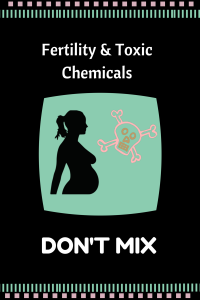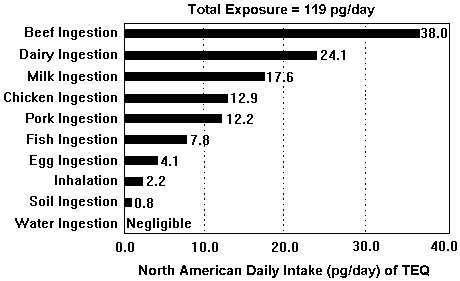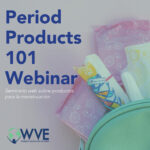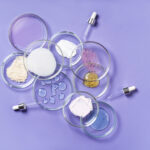The Filthy Five of Toxic Chemicals and Fertility
 |
|
Nicole Thompson WVE Actionista |
Did you know that the chemicals you are subjected to today can affect not only your fertility, but potentially your offspring’s ability to have children of their own? I certainly didn’t realize the magnitude of the long lasting effects of some of the toxic chemicals that are in the products that we use on a daily basis.
This article will only scratch the surface of this issue, but I implore you to dive into the rabbit hole that is “toxic chemicals.” Any chemical that may negatively affect your endocrine system is negatively impacting your reproductive system.
Five Filthy Endocrine Disruptors
Phthalates
These have been found to lower sperm count and mobility, and they play a role in other hormonal and reproductive changes. Phthalates can trigger what’s known as “death-inducing signaling” in testicular cells, which means that it makes them die earlier then they should. That’s not all either. Studies have linked phthalates to these other harmful effects as well hormone changes, lower sperm count, less mobile sperm, birth defects in the male reproductive system, and thyroid irregularities. So not only are sperm dying young, there are also less of them that actually have a chance to reach their goal.
What products contain phthalates?
Plastic food containers, some children’s toys (though in 2008, the U.S. Congress passed a law that banned certain phthalates in products for children under 12), as well as plastic wrap made from PVC (recycling label #3). There are also many beauty products that may include phthalates: nail polish, hair sprays, aftershave lotions, soaps, shampoos, perfumes, and other fragrance preparations.
Lead
Lead harms almost every organ system in the body and has been linked to widespread health effects. What you may not know (I certainly didn’t) is that it has been found to lower sex hormone levels. This lowered amount of hormone levels has been linked to miscarriage, reduced fertility in men and women, and delays in puberty onset in girls. There is also research that has shown that lead can disrupt the hormone signaling that regulates the body’s major stress system (called the HPA axis). The majority of people I know have stress, so the last thing we all need is a chemical making it harder for our bodies to deal with it.
What products contain lead?
Lead may be a contaminant in over 650 cosmetic products, including sunscreens, foundation, nail colors, lipsticks, and whitening toothpaste.
Dioxin
Dioxin is not listed on ingredient labels (I know, scary). It’s a petroleum-derived contaminant formed in the manufacturing of shampoos, body wash, children’s bath products, and other types of cosmetics (so a ton of items we all use on a daily basis). The International Agency for Research on Cancer (IARC) has ranked it as a possible carcinogen, and the National Toxicology Program (NTP) has identified it as a reasonably anticipated carcinogen.
Recent research has shown that exposure to low levels of dioxin in the womb and early in life can both permanently affect sperm quality and lower the sperm count in men during their prime reproductive years.
What products contain dioxin?
Tampons, meat and dairy products
This chart shows how much you may be ingesting:
If you’re eating the typical North American diet, this is where you are getting your dioxin from:
Chart from EPA Dioxin Reassessment Summary 4/94 – Vol. 1, p. 37
(Figure II-5. Background TEQ exposures for North America by pathway)
Glycol Ethers
The European Union (EU) says that glycol ethers “may damage fertility or the unborn child.” Studies of painters have linked exposure to certain glycol ethers to blood abnormalities and lower sperm counts. Shrunken testicles is one effect that happened on exposed rats. Pretty sure that is going to affect their reproductive abilities.
What products contain glycol ethers?
Paints, perfumes, soaps, cosmetics, and foods
Nonylphenol ethoxylates (NPEs)
Known to be a potent endocrine disrupter. Nonylphenol causes the feminization of aquatic life, decreases male fertility, and decreases survival in young fish. Studies have also shown that male fish exposed to nonylphenol have lower testicular weight. So this basically means that male fish turn into females, and those that remain have lower chances to be able to reproduce. Aren’t there already more females in the world, so this not only potentially affects the balance of nature, but what is it doing to our bodies when we are exposed?
What products contain NPEs?
Laundry detergents and all-purpose cleaners (banned in Europe), used in manufacturing lubricating oil additives, laundry and dish detergents. These compounds are also forerunners to the commercially used chemicals which are used in paints, pesticides, personal care products, and plastics.
I encourage you to go down the path of researching all of the toxins that can possibly affect fertility not just for ourselves but also our future generations.
*Check out WVE’s tips for avoiding toxic chemicals before, during and after pregnancy for other ideas!

Sources:
* http://www.ewg.org/research/dirty-dozen-list-endocrine-disruptors
* http://www.breastcancerfund.org/clear-science/environmental-breast-cancer-links/cosmetics/
* http://www.who.int/mediacentre/factsheets/fs225/en/
* http://www.ejnet.org/dioxin/
* Soares, A., B. Guieysse, B. Jefferson, E. Cartmell, and J.n. Lester. “Nonylphenol in the Environment: A Critical Review on Occurrence, Fate, Toxicity and Treatment in Wastewaters.” Environment International 34.7 (2008): 1033-049.
* WHO (World Health Organization). 2002. Integrated Risk Assessment: Nonylphenol Case Study. WHO/IPCS/IRA/12/04, World Health Organization, Geneva, Switzerland.








Very informative, and so easy to understand. 🙂